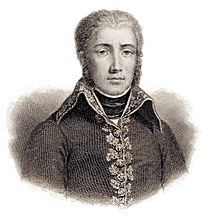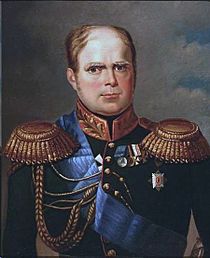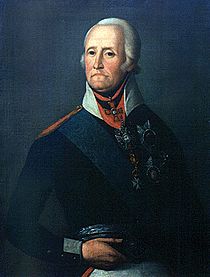Battle of Bassignana (1799) facts for kids
Quick facts for kids Battle of Bassignana (1799) |
|||||||
|---|---|---|---|---|---|---|---|
|
|||||||
| Belligerents | |||||||
| Commanders and leaders | |||||||
| Strength | |||||||
| Casualties and losses | |||||||
| 617 | 992–2,000; 2–4 guns | ||||||
The Battle of Bassignana took place on May 12, 1799. It was a fight during the French Revolutionary Wars. A group of Russian soldiers, led by Andrei Grigorevich Rosenberg, tried to cross the Po River in Italy. They wanted to set up a strong position on the south side of the river.
However, the French army, led by Jean Victor Marie Moreau, quickly gathered more troops. They attacked the Russians. After hours of intense fighting, the Russians had to give up their river crossing. They lost many soldiers. This battle happened near the town of Bassignana, in Italy.
This battle was part of the War of the Second Coalition. In the spring of 1799, Austrian and Russian armies had won many battles. They pushed the French out of northern Italy. The main leader of the combined armies, Alexander Suvorov, wanted to remove the French from the rest of Italy.
Suvorov told his general, Rosenberg, to cross the Po River at a specific spot. But Rosenberg, possibly influenced by Grand Duke Constantine Pavlovich of Russia, chose a different, less safe spot. Two of Moreau's French divisions quickly attacked the Russians. The French won this battle. Even so, Bassignana was only a small setback for the Allies. A few days later, the French launched another attack, leading to the First Battle of Marengo.
Contents
Background to the Battle
The fighting in 1799 started with the Battle of Verona on March 26. This battle was a draw between the Austrian army and the French Army of Italy. On April 5, the Austrians, with 46,000 soldiers, defeated the French in the Battle of Magnano. The French lost many soldiers and cannons.
The French general, Barthélemy Louis Joseph Schérer, was very upset. He left some soldiers to defend the city of Mantua and then retreated. The Siege of Mantua lasted for months. Other smaller French groups were quickly forced to surrender. After these losses, the French Army of Italy had only about 28,000 soldiers left. Everyone in the French army was losing hope. To make things worse for the French, the famous Russian general Alexander Suvorov arrived. He took command of the combined Austrian and Russian armies.
The French government accepted General Schérer's resignation. He gave command of the army to Jean Victor Marie Moreau on April 26, 1799. The very next day, Suvorov attacked and won the Battle of Cassano. Moreau's army lost many soldiers and had to retreat. One of his generals, Jean-Mathieu-Philibert Sérurier, and 2,400 of his men were cut off. They had to surrender that evening.
Moreau and his general, Paul Grenier, retreated west to Turin. Then, they crossed to the south side of the Po River and marched east again. Another French general, Claude Perrin Victor, crossed the Po River at Casale Monferrato. He took a position near the strong city of Alessandria. When Grenier joined Victor there on May 7, Moreau had about 20,000 soldiers. Their right side was protected by Alessandria. Their left side was at Valenza.
On May 6, 1799, Suvorov's left wing crossed the Po River at Piacenza. They moved southwest. His main army crossed further west. On May 7, a large Austrian group was at Castel San Giovanni. A Russian advance group was at Voghera. Both were on the south side of the Po River. General Rosenberg, with over 10,000 soldiers, was on the north side. That same day, Grand Duke Constantine arrived. He was very eager for action.
On May 9, Suvorov's chief of staff, the Austrian Johann Gabriel Chasteler de Courcelles, chased the French out of Tortona. Suvorov wanted his army to be on the south side of the river. He ordered Rosenberg to cross the Po River downstream from where the Po and Tanaro rivers meet.
The Battle Begins
Instead of following Suvorov's orders, General Rosenberg started sending his troops across the Po River near Bassignana. This was upstream from where the Tanaro River flows into the Po. It is almost certain that Grand Duke Constantine told Rosenberg to ignore Suvorov's instructions.
At first, the Allies thought the town of Valenza was empty. So, on May 8, they planned to cross the Po there. But on May 10, they found out the French were holding Valenza. During this time, a Russian officer named Nikolay Andreyevich Chubarov found an island in the Po River. It seemed like a good place to cross. Chubarov set up a "flying bridge" from the north bank to the island. This was a ferry boat pulled by a cable. The Russian preparations were so obvious that Moreau thought it was a trick. He believed the Russians were just pretending to attack there. So, he told Grenier to leave only a few guards. He ordered Grenier's main division to march south to Alessandria. Moreau thought the real threat was from Suvorov to the east.
On the evening of May 11, 1799, Rosenberg sent 4,000 Russian soldiers to the island. These included special grenadier battalions, jäger (light infantry) companies, and Cossack cavalry. Other soldiers crossed in small boats. The Russians waited on the island until morning. On May 12, the Russians waded through two deep parts of the river. Local people showed them where to cross. Grand Duke Constantine crossed early and led the troops. They quickly pushed away Grenier's French guards. The people of Bassignana welcomed the Russians. They even chopped down a "Tree of Liberty" that the French had planted. At this time, Rosenberg began sending more troops from the north bank to the island. The Russians on the south bank moved southwest. They started fighting the French near the village of Pecetto di Valenza.
There are slightly different stories about what happened next. One story says that the French soldiers at Pecetto and a nearby hill pushed back the first Cossack attack. Russian infantry arrived in the afternoon. By 4:15 PM, they forced the French out of Pecetto. By then, Moreau realized this was a real attack. He ordered Grenier's division to turn back and fight the Russians. He also sent his reserve troops and ordered Victor's division to hurry to the scene. When Grenier's division attacked, they quickly took back Pecetto. Chubarov tried hard to rally his Russian soldiers to stop the French.
Another story says that Moreau, who was in Valenza, told his guards in Bassignana to fall back. Chubarov advanced with Cossacks and 2,500 infantry. Grenier's division faced east, with Valenza on their left. Their line included the high ground of the Sant' Antonio ridge and Pecetto. Grenier placed his brigades carefully. Moreau ordered Victor to march quickly to the battlefield from the south. Around 1:00 PM, the Russians, led by Constantine, attacked the French at Pecetto. But they were pushed back again and again. When Victor's troops started appearing on the hills to the south, the Russians became nervous and began to retreat.
At this point, an officer from Suvorov arrived with new orders. The order said that Suvorov had given up on taking Valenza. It told Rosenberg to send as many troops as possible to join Suvorov's main army. It also said to leave only a few guards near Valenza. The officer ordered that no more troops should cross the Po. He told the soldiers already on the south bank to leave. But Constantine quickly came back and ignored the staff officer. He ordered more Russian battalions to join the battle. One Austrian observer wrote that the Russian soldiers' bravery saved them from being completely wiped out. However, a Russian captain admitted that the retreat turned into a messy escape. Soldiers ran away, ignoring their officers. Meanwhile, the people of Bassignana, who had welcomed the Russians that morning, now cheered and even shot at them as they fled.
If Victor's French division had joined the fight, all the Russian soldiers might have been captured. But Victor's troops were too tired and hungry to march any further. To distract the French, Rosenberg ordered two battalions to make a show of force near Valenza. He also ordered another general to attack Casale Monferrato. Both these actions failed. Any Russian troops who reached the south bank of the Po were killed, captured, or driven away.
By evening, the Russian survivors from Bassignana returned to the island. But they couldn't cross to the north bank. A local person had cut the cable for the ferry. It took time to get the ferry back. Once the bridge was working again, the wounded soldiers were sent to the north bank first. The healthy soldiers had to wait. While the Russians were stuck on the island, French cannons started firing at them in the dark. Constantine's horse jumped into the river. A Cossack swam to him and saved him. At 2:00 AM, Constantine crossed to the north bank in a small boat. His assistant used a spear to push the boat.
Results of the Battle
The French army lost about 617 soldiers in the Battle of Bassignana. Suvorov admitted that his Russian soldiers lost 992 men. Other estimates for Russian losses were higher, up to 2,000 soldiers. The Russians also lost 2 to 4 cannons. The French had about 12,000 soldiers, while the Russians had between 3,500 and 7,000. French General Quesnel was wounded. The Russians lost several officers, including General-major Chubarov, who was wounded.
It was impossible to officially blame the Tsar's son, Grand Duke Constantine, for the defeat. General Rosenberg wrote to Suvorov, taking the blame himself. Suvorov then created an official report that followed Rosenberg's story. It said that the order to retreat arrived too late. Suvorov praised his soldiers, saying they were close to victory when someone mistakenly signaled a retreat. Suvorov also found fault with another general's failed operation. Finally, Suvorov had a private talk with Constantine. The Grand Duke left with tears in his eyes. Suvorov then scolded Constantine's assistant, threatening to send him home if he let the Grand Duke get into trouble again.
Moreau saw that Suvorov's army was split by the Po River. Most of the Russians were on the north bank, and most of the Austrians were on the south bank. Moreau gathered most of his army near Alessandria. On May 16, he sent Victor's division to scout eastward toward Tortona. This led to an Allied victory in the First Battle of Marengo.
Who Fought in the Battle
The French army was led by General Jean Victor Marie Moreau. His main generals were Paul Grenier and Claude Perrin Victor. The French had about 12,000 soldiers in total.
The Russian forces were led by General Andrei Grigorevich Rosenberg. He was influenced by Grand Duke Constantine Pavlovich of Russia. Other important Russian generals included Nikolay Chubarov and Ivan Ivanovich Dalheim. The Russians had between 3,500 and 7,000 soldiers. They also had some Austrian cavalry.
See also
Images for kids







